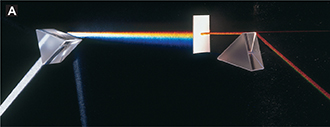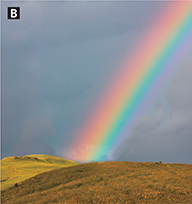Figure 23 White light is dispersed by prisms and water droplets. A When white light passes through a prism, the shorter wavelengths are bent more than the longer wavelengths. The colors are separated. When red light enters the second prism, it is refracted but the color does not change. B Water droplets separate the colors of sunlight, producing a rainbow.


Separating White Light Into Colors
In 1666, the English physicist Isaac Newton investigated the visible spectrum. First, he used a glass prism to produce a visible spectrum from sunlight. With screens, he then blocked all colors of light except blue. Next, he placed a second prism where the blue light was visible. The second prism refracted the blue light but had no further effect on the color. Newton's experiments showed that white sunlight is made up of all the colors of the visible spectrum.
How does a prism separate white light into a visible spectrum?  As white light passes through a prism, shorter wavelengths refract more than longer wavelengths, and the colors separate. Look at Figure 23A. When red light, with its longer wavelength, enters a glass prism, it slows down the least of all the colors, and so is bent the least. Violet light is bent the most. The process in which white light separates into colors is called dispersion.
As white light passes through a prism, shorter wavelengths refract more than longer wavelengths, and the colors separate. Look at Figure 23A. When red light, with its longer wavelength, enters a glass prism, it slows down the least of all the colors, and so is bent the least. Violet light is bent the most. The process in which white light separates into colors is called dispersion.
A rainbow gives a beautiful example of dispersion. Droplets of water in the air act like prisms. They separate sunlight into the spectrum. When light enters a raindrop, it slows down and refracts. Then it reflects off the far inner surface of the raindrop. It refracts again as it exits the raindrop, speeds up, and travels back toward the source of the light.
What process causes a rainbow?
The Colors of Objects
Would it surprise you to learn that an object of any color does not have a definite color? An object's color is the color of light that reaches your eye when you look at the object.  The color of any object depends on what the object is made of and on the color of light that strikes the object. Sunlight contains all the colors of the visible spectrum. But when you look, for example, at a red car in sunlight, the red paint reflects mostly red light. Most of the other colors in white light are absorbed at the surface of the paint.
The color of any object depends on what the object is made of and on the color of light that strikes the object. Sunlight contains all the colors of the visible spectrum. But when you look, for example, at a red car in sunlight, the red paint reflects mostly red light. Most of the other colors in white light are absorbed at the surface of the paint.






